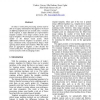Free Online Productivity Tools
i2Speak
i2Symbol
i2OCR
iTex2Img
iWeb2Print
iWeb2Shot
i2Type
iPdf2Split
iPdf2Merge
i2Bopomofo
i2Arabic
i2Style
i2Image
i2PDF
iLatex2Rtf
Sci2ools
ICDAR
2009
IEEE
2009
IEEE
A Generic Form Processing Approach for Large Variant Templates
In today's world, form processing systems must be able to recognize mutant forms that appear to be based on differing templates but are actually only a variation of the original. A single definition of a representative template actually covers large varieties of the same logical templates. We developed a method and system, similar to the human visual system, which differentiates between templates via features such as logos, dominant words, and geometrical shapes, while ignoring minor details and variations. When the system finds an appropriate template, it then decodes the content of the form. Our approach has been applied in several scenarios with encouraging results.
Document Analysis | Form Processing Systems | ICDAR 2009 | Logical Templates | Representative Template |
Related Content
| Added | 18 Feb 2011 |
| Updated | 18 Feb 2011 |
| Type | Journal |
| Year | 2009 |
| Where | ICDAR |
| Authors | Yaakov Navon, Ella Barkan, Boaz Ophir |
Comments (0)

